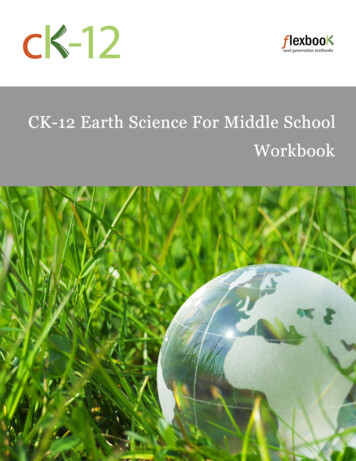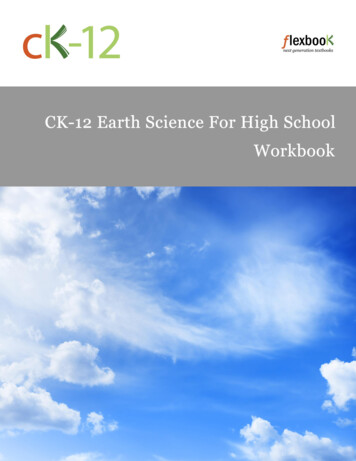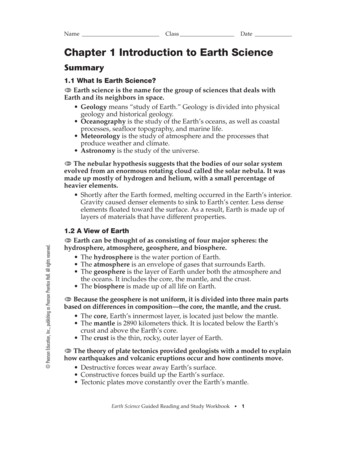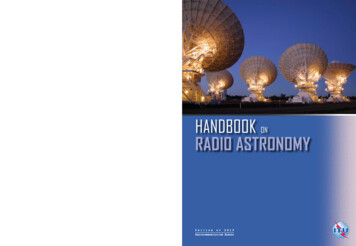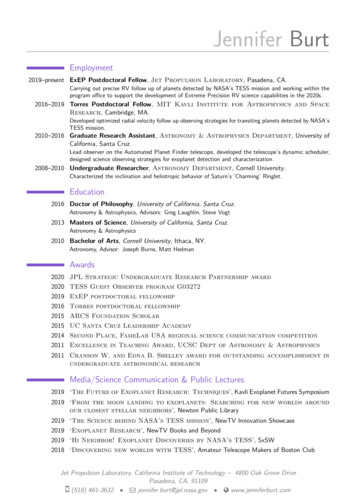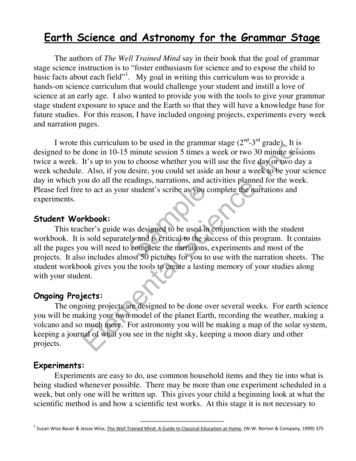
Transcription
Earth Science and Astronomy for the Grammar StageThe authors of The Well Trained Mind say in their book that the goal of grammarstage science instruction is to “foster enthusiasm for science and to expose the child tobasic facts about each field”1. My goal in writing this curriculum was to provide ahands-on science curriculum that would challenge your student and instill a love ofscience at an early age. I also wanted to provide you with the tools to give your grammarstage student exposure to space and the Earth so that they will have a knowledge base forfuture studies. For this reason, I have included ongoing projects, experiments every weekand narration pages.emen Sta amlS plci eence,Inc.I wrote this curriculum to be used in the grammar stage (2nd-3rd grade). It isdesigned to be done in 10-15 minute session 5 times a week or two 30 minute sessionstwice a week. It’s up to you to choose whether you will use the five day or two day aweek schedule. Also, if you desire, you could set aside an hour a week to be your scienceday in which you do all the readings, narrations, and activities planned for the week.Please feel free to act as your student’s scribe as you complete the narrations andexperiments.Student Workbook:This teacher’s guide was designed to be used in conjunction with the studentworkbook. It is sold separately and is critical to the success of this program. It containsall the pages you will need to complete the narrations, experiments and most of theprojects. It also includes almost 50 pictures for you to use with the narration sheets. Thestudent workbook gives you the tools to create a lasting memory of your studies alongwith your student.ElOngoing Projects:The ongoing projects are designed to be done over several weeks. For earth scienceyou will be making your own model of the planet Earth, recording the weather, making avolcano and so much more. For astronomy you will be making a map of the solar system,keeping a journal of what you see in the night sky, keeping a moon diary and otherprojects.Experiments:Experiments are easy to do, use common household items and they tie into what isbeing studied whenever possible. There may be more than one experiment scheduled in aweek, but only one will be written up. This gives your child a beginning look at what thescientific method is and how a scientific test works. At this stage it is not necessary to1Susan Wise Bauer & Jessie Wise, The Well Trained Mind: A Guide to Classical Education at Home, (W.W. Norton & Company, 1999) 375
,Inc.ask your student to predict the outcome of the experiment as they have no knowledgebase to determine what the answer should be. However, if your student enjoyspredicting, you can feel free to let them do so. All the pages you need are included in thestudent workbook.Generally, the experiment write-up page includes four sections, what we used,what we did, what happened and what I learned. The “what we used” section is for youto write the materials that you used when completing the experiment. The “what we did”section is for you to write a brief description of what you did for the experiment. The“what happened” section is for you to write down what your student observed during theexperiment. Finally, the “what I learned” section is for you to write down what yourstudent learned from the experiment. Any time you see a box for a picture of yourexperiment you can have your child draw what is there or you can take a picture and glueit in the box. At this point I recommend that you begin to have your student copy theinformation onto the experiment pages in their own writing.emen Sta amlS plci eenceNarrations:The narration sheets are designed to be a record of what you have studied. Theyare to be completed after you have done the daily reading for a particular topic. Irecommend that you have your student dictate their narration to you and then begin tohave them copy it into their student workbook. If your student is having difficultyknowing what to say, you could ask; What was one thing you learned about ? orWhat do you like the best about ? Only expect one to two sentences. Then glue thepicture of what you studied on the sheet and let your student color it (if your student isartistic you could let them draw this on their own). All the pages and pictures you needfor the narrations are included in the student workbook. Review these pages monthly sothat your student gets a review of what they have been learning.ElOther Features: You will find vocabulary words scheduled throughout the curriculum. These aredesigned to be done orally and are completely optional. I have put togethervocabulary cards that you can use to aid your student in recall. These can be foundat the Elemental Science yahoo group. You will also find that before each unit I have included an overview of the study, alist of materials needed by week and a list of simple poems that you can use to helpyour child memorize. These poems are included as a resource for you to enhanceyour students learning. You will also find the “Want More?” boxes on each of the plan sheets. These aredesigned to give you ideas for more activities and for additional reading within theplanned books. You will also notice that Day 5 of the 5 day schedule is usually planned to berather light. This is so you can easily fit in additional activities or use the time fornature study. For nature study, I recommend using the Handbook of Nature Study.
Another option is to use day 5 to study the scientists of the Middle Ages. I haveput together a book that you could use called Great Scientists of the Middle Ages,which is available for free download at www.greatscientsseries.blogspot.com. In the Appendix of this guide I have included the following Teacher Helps: This includes directions for projects, the constellation studyand a scientist biography sheet. Blank pages: These are blank versions of the narration pages and theexperiment page in case your student wants to do more!Be sure to visit the Elemental Science yahoo group for additional supplemental materials,such as vocabulary cards and additional templates that you can use for the variousprojects in this guide.emen Sta amlS plci eence,Inc.Quizzes:After the appendix in this guide I have included quizzes that you can use everyweek. Although they are not essential, they are helpful in assessing how much yourstudent is retaining or to use as a review of what you have studied during the past week.You can choose to give these orally or copy them for your student to fill out.ElWhat if I have an older student? How do I include them?If you want your older student to work along with your other students and you feelthe resources are to “easy” for them. Simply use the following books instead Usborne’s Internet-linked Science Encyclopedia—not all of the topics are coveredin this resource, but the articles are written at a higher level and contain moreinformation Usborne’s Book of Astronomy and Space Usborne’s Encyclopedia of Planet EarthHave your older child look up the corresponding section in their book and read it, thenlook up the websites if applicable. (I have included a topical index in this guide to aidyou in this.) Next have them write about the topic. If you want more than just a simplenarration, have them write a mini-report (one to two paragraphs) on a separate sheet andpaste the picture to that. I would suggest that you let your older student do all their ownwriting for this program.Special Considerations:In writing this curriculum I ran into two problems with the books available forstudy. The first is Creation vs. Big Bang theory. I believe that God created the Earth, theHeavens and everything in it in seven days, but many books teach the Big Bang theory. Ihave endeavored to write each of my curriculums to be religiously neutral, but I find thatwhen it come to earth science and astronomy it is nearly impossible, since your religiousbeliefs play into your belief of the origins of the Earth. So beware, depending on yourbeliefs, you made need to explain what you believe and why.
The second problem is Pluto as a planet. You may remember that in August of 2006Pluto was removed as a planet. The books that are currently in print don’t reflect thischange. I have added links to articles concerning the decision in this guide. I trust thatyou, as parent and teacher, will choose how to explain these differences to your student.Elemen Sta amlS plci eence,Inc.Final Thoughts:As the author and publisher of this curriculum I encourage you to contact me withany questions or problems that you might have concerning Earth Science and Astronomyfor the Grammar Stage. I will be more than happy to answer them as soon as I am able.You can email me at info@elementalscience.com. You may also get additional help atour yahoo group (http://groups.yahoo.com/group/elemental science/). I hope that youwill enjoy Earth Science and Astronomy for the Grammar Stage!
Copyright PolicyAll contents copyright 2009, 2010 by Elemental Science, Inc. All rights reserved.No part of this document or the related files may be reproduced or transmitted in anyform, by any means (electronic, photocopying, recording, or otherwise) without the priorwritten permission of the publisher. The publisher does give permissions for the originalpurchaser to make copies of the supplemental material for use within their immediatefamily.emen Sta amlS plci eence,Inc.Limit of Liability and Disclaimer of Warranty: The publisher has used its best efforts inpreparing this book, and the information provided herein is provided "as is." ElementalScience, Inc. makes no representation or warranties with respect to the accuracy orcompleteness of the contents of this book and specifically disclaims any impliedwarranties of merchantability or fitness for any particular purpose and shall in no event beliable for any loss of profit or any other commercial damage, including but not limited tospecial, incidental, consequential, or other damages.ElTrademarks: This book identifies product names and services known to be trademarks,registered trademarks, or service marks of their respective holders. They are usedthroughout this book in an editorial fashion only. In addition, terms suspected of beingtrademarks, registered trademarks, or service marks have been appropriately capitalized,although Elemental Science, Inc. cannot attest to the accuracy of this information. Use of aterm in this book should not be regarded as affecting the validity of any trademark,registered trademark, or service mark. Elemental Science, Inc. is not associated with anyproduct or vendor mentioned in this book.
Book Listemen Sta amlS plci eenceBooks for Astronomy: Usborne First Encyclopedia of Space Kingfisher’s Young Knowledge Solar System Janice VanCleave’s Astronomy for Every Kid Usborne Spotter’s Guide: The Night Sky Who Was Neil Armstrong (only need for 1 week),IncBooks for Earth Science: Usborne First Encyclopedia of Our World Kingfisher’s Young Knowledge Rocks and Fossils Janice VanCleave’s Earth Science for Every Kid a library book on tornadoes and hurricanes.I used the following books when planning this curriculum. The Usborneencyclopedias and the Kingfisher Young Knowledge books are essential and I recommendpurchasing these. If you intend on performing the experiments listed you will need theJanice VanCleave books since all the experiments are from there. You could check thesebooks out from the library, but you will need them for the 18 weeks, so keep that in mind.Abbreviations used:El JVC Earth Science—Janice VanCleave’s Earth Science for Every Kid JVC Astronomy—Janice VanCleave’s Astronomy for Every Kid SG—Student Workbook
Earth Science Scope and Sequenceemen Sta amlS plci eenceBooks used:,Inc.Ongoing activities: Making a model Planet Earth Weather and Rain Gauge: For 4 weeks you will measure rain and record theweather. Rock Collection: Your student will make their own rock collection. Volcano Exploding: You and your student will make a model of a volcano andexplode it. Narration Pages: Picture if possible and child’s summary of what learned. Experiment Pages: Fill out an experiment page once a week for the experimentperformed. Vocabulary Usborne First Encyclopedia of Our World Kingfisher’s Young Knowledge Rocks and Fossils Janice VanCleave’s Earth Science for Every KidElSequence for Study: Week 1&2—Earth & Moon Week 3—Seasons & Weather Week 4&5—Natural Disasters Week 6—Mountains & Rivers Week 7—Oceans Week 8—Biomes Week 9—Underground Week 10-13—Rocks Week 14-16—Fossils Week 17 & 18—Caring for Earth
Earth Science Materials at a GlanceWeek 1Week 2Week 3Week 4Week 6emen Sta amlS plci eenceWeek 7,Inc.Week 52 thermometers, 2 plastic bags, one large, one small both withtwist ties, flour and water, newspaper, balloon, globe2 eggs (1 raw, 1 hard-boiled), marking pen, paint(blue, green& brown), table, flashlight, dark shirt, hand-mirrorPlastic Water Bottle, Duck Tape, Sharpie marking pen, Smallmarbles or rocks, RulerAluminum pan, Play sand or dirt, Small play houses andpeople2-2 liter soda bottles, Duct tape, Scissors, Pencil, Papertowels, ruler, Old aluminum pan (at least 9x13), Small bottle(about 20 cm tall), Homemade salt dough or modeling clayPaints-brown and red, Optional—small sticks and lichens todecorate, Baking soda, Liquid dish soap, Red and yellow foodcoloring, Vinegar, Freezer with a wire rack, Square cake pan,A brickBlue food coloring, 2 clear drinking glasses, 2 coffee cups, 1liter jar, Eyedropper, Ice**No experiment this week **Epsom salts, 2 small baby food jars, Cotton string, Scissors, 2washers, Spoon, ruler, paperPencil, Half empty toothpaste tube3 seashells, vinegar, glass20 flat toothpicks, BookSponge, bar of soapCake pan, Rock about the size of your fistPaper plate, Paper cup, Modeling clay, Seashell, Petroleumjelly, Plaster of Paris, Plastic spoonMeasuring cup, Epsom salts, Measuring spoon, Scissors,Black construction paper, Lid from a large jarChalk, Vinegar, Glass*No Experiment this week*Week 8Week 9Week 10Week 11Week 12Week 13Week 14Week 15Week 16ElWeek 17Week 18
Earth Science Lesson Plans Week 1Day 1Usborne OurWorldPg. 4-5Our planetExperiment forWrite-Up:Cold ‘n Hot(SG pg. 55)Day 3Day 4Day 5Usborne OurWorldPg. 6-7What’s in SpaceUsborne OurWorldPg. 8-9Moon Narration Sheet(SG pg. 21)Narration Sheet(SG pg. 21)Picture(SG pg. 89) Begin yourmodel ofplanet EarthFinish otheractivitiesDo the InternetQuick-linksfrom Usbornefor the weekGive EarthScience Week1 Quiz.Narration Sheet(SG pg. 21)Picture(SG pg. 89)Day 2Review Vocabulary daily and look for it in your readingsemen Sta amlS plci eenceIntroduceVocabulary,Inc Narration Sheet: As you go through the week you will be doing narrations after you read a section. Ifthey have trouble getting their thoughts out, ask questions like What was your favorite part about? What is one thing you learned today about ? Expect 1-2 sentences a day. When theyare finished have them color the picture.Want More?Vocabulary: Space—the region beyond the atmosphere of EarthMaterials needed this week: 2 thermometers 2 plastic bags, one large, one small both with twist ties Flour and water Newspaper Balloon globe Make a model moon to gowith your earthElExperiment for Write-up (Day 2): Cold ‘n HotSee JVC Earth Science pg. 126-127 for directions. This experiment will help your child tounderstand how the Earth’s temperature remains constant.Model of Planet Earth (Day 5): This week you will make your model of planet Earth. See thefollowing page for instructions.
Earth Science Lesson Plans Week 1 (2-day)Day 1Day 2ReadingsUsborne Our WorldPg. 4-5 Our planetUsborne Our WorldPg. 6-7 What’s in Space &Pg. 8-9 MoonActivityNarration Sheet (SG pg. 21) Picture(SG pg. 89) & Experiment for Write-Up:Cold ‘n Hot (SG pg. 55)Narration Sheet (SG pg. 21)Picture (SG pg. 89)Begin your model of planet Earth &Do the Internet Quick-links from Usborne for the Introduce Vocabulary & Look for theVocabulary in your ReadingOral Vocabulary Test &Give Earth Science Week 1 Quizemen Sta amlS plci eenceNarration Sheet: As you go through the week you will be doing narrations after you read a section. Ifthey have trouble getting their thoughts out, ask questions like What was your favorite part about? What is one thing you learned today about ? Expect 1-2 sentences a day. When theyare finished have them color the picture.Want More?Vocabulary: Space—the region beyond the atmosphere of EarthMaterials needed this week: 2 thermometers 2 plastic bags, one large, one small both with twist ties Flour and water Newspaper Balloon globe Make a model moon to gowith your earthElExperiment for Write-up (Day 1): Cold ‘n HotSee JVC Earth Science pg. 126-127 for directions. This experiment will help your child tounderstand how the Earth’s temperature remains constant.Model of Planet Earth: This week you will make your model of planet Earth. See the following pagefor instructions.
Directions for Model Planet EarthMaterials Used: BalloonNewspaperFlourWaterSaltGlobePaint (blue, green, brown),Inc.Recipe for Paste:Directions:Blow up the balloonTear Newspaper into stripsMake the pasteDip strips in to paste and put one layer on the balloonAdd a second layer, as you do this be sure to look the globe and add any topographical features(ie. Mountains)6. Let Dry7. Once dry, pop the balloon8. Paint your planet using the globe as a guideEl1.2.3.4.5.emen Sta amlS plci eenceMix one part flour with about 2 parts of water until you get a consistency like thick glue. Addmore water or flour as necessary. Mix well to get out all the bumps. Add a few tablespoons of saltto help prevent mold!
My Planet Earth ModelA picture of my modelemen Sta amlS plci eence,Inc.Sample fromStudent WorkbookWhat I learned El
Earth Science Narration PageOur Planet:,Inc.emen Sta amlS plci eenceWhat’s in Space:Sample fromStudent WorkbookMoon:Pictures are included, but theyElare on a separate sheet to be cutout and colored by child, thenpasted in the squares.
Name:Date:Cold ‘n Hot: How does the Earth’sheat level remain constant?What we used Sample fromStudentWorkbook,Inc.What we did emen Sta amlS plci eenceWhat happened Results ChartThermometerFreein a BagThermometerElInitialTemperatureTemperatureafter 30 min. inthe sunTemperatureafter 30 min. ina dark closetWhat I learned
Earth Science Week 11. True or False: The Earth is made up of rock and metal.2. The atmosphere helps protect us from the heat andlight.stars.Sun’s3. The moon has air.somenoemen Sta amlS plci eencea lot of,IncMoon ‘s4. What is the most interesting thing you learned this week?El
Astronomy Scope and Sequence (18 weeks),Inc.Ongoing activities: Map of the Solar System: As you study a part of the solar system you will put it onthe map Night Sky Diary: When you observe the night sky use these sheets, at the end of thestudy put them together in a mini-book Moon Diary: For 29 days you will observe the changes in the moon every night, ifpossible Scientist Biography Narration Pages: Picture if possible and child’s summary of what learned VocabularyBooks used:Usborne First Encyclopedia of SpaceKingfisher’s Young Knowledge Solar SystemJanice VanCleave’s Astronomy for Every KidUsborne Spotter’s Guide: The Night SkyWho Was Neil Armstrong (or another book about Neil Armstrong from the library)emen Sta amlS plci eence ElSequence for Study: Week 1-12 Solar System: Sun Mercury Venus Earth Moon Mars Jupiter Saturn Uranus Neptune Pluto Asteroids, Meteors, Comets Week 13-15 Stars Week 16-17 Seeing into space and space travel Week 18 Scientist biography
Astronomy Materials at a GlanceWeek 5Week 6Week 7Week 8Week 9emen Sta amlS plci eenceWeek 10.Week 42 thermometers, Desk lamp, yardstickClear, plastic ballpoint penDesk lamp, Pencil2 thermometers, 1 jar with lid tall enough to hold one of thethermometersString and ruler, Metal washer, Scissors, Paper, Masking tape,Book2 thermometersWide mouthed jar, Tea bag, PencilTape, Ruler, White poster board, Black marker, Straight pin,Scissors, pencil, glueDesk lamp, 2 thermometers, Ruler, Construction paper, oneblack & one white, 2 empty metal cans, Scissors, tape2 clear drinking cups, 2 pennies, 2 grape-sized pieces ofmodeling clayYardstick, Ruler, Modeling clayCurling ribbon(about 3 feet long), Tennis ball, Straight pin,Foil, Newspaper, Carbon paper, Typing paper, 1 golf ballAluminum foil, Flashlight, Glass bowl, PencilShoe box, Black construction paper, Flashlight, Nail orstraight pin, Tape and ScissorsPlanetarium, Flashlight, Black Construction paperWhite paper-3 sheets, Tape, Desk lamp, Scissors2 thermometers, 2 glasses, Aluminum foil, Rubber glove,Desk lamp, Cotton handkerchiefLiquid cooking oil, 1 clear glass, Eye dropper, Water,Rubbing alcohol,IncWeek 1Week 2Week 3Week 11Week 12Week 13Week 14Week 15Week 16Week 17ElWeek 18
Astronomy Lesson Plans Week 12Narration Sheet(SG pg. 48)Picture(SG pg. 107)IntroduceVocabularyUsborne Spotter’sGuidePg. 44-45Comets &AsteroidsMake a comet(directions arebelow)Narration in SG onpg. 48Day 3Usborne Spotter’sGuidePg. 50-51MeteorsNarration Sheet(SG pg. 48)Picture(SG pg. 107)Day 4Day 5 Experiment forWrite-Up:Plop(SG pg. 82) Review whatyou havelearned aboutthe solarsystemGiveAstronomyWeek 12 Quiz.Usborne SpacePg. 42-43Bits & PiecesDay 2,IncDay 1Review Vocabulary daily and look for it in your readingsemen Sta amlS plci eenceNarration Sheet: As you go through the following weeks you will be doing narrations after you readeach section. If they have trouble getting their thoughts out, ask questions like What was yourfavorite part about ? What is one thing you learned today about ? Expect 1-2 sentences aday. When they are finished have them color the picture.Vocabulary: Meteor—a meteoroid that burns up in the planet’satmosphere, also called a shooting star. Want More?Draw a comet on black paperusing a white crayon. Thenuse silver glitter to decorateit.Directions for Making a Comet (Day 2): Cut curling ribbon inlengths, curl them and tie them together at one end. Pin thetied end of the ribbon onto the tennis ball using the straightpins. Cut a piece of foil, about 7" x 7" and cover the ball allowing the comet's tail (ribbon) to comeout through the foil. You can now play with your comet! Put a picture of your comet on thenarration page, SG pg. 48.ElExperiment for Write-up (Day 4): PlopSee JVC Astronomy pg. 116-117 for directions. This experiment will help your child todetermine how craters are formed by falling meteorites.Materials Needed This Week: Curling ribbon(about 3 feet long) Tennis ball Straight pin Foil Newspaper Carbon paper Typing paper 1 golf ball
Astronomy Lesson Plans Week 12 (2-day)Day 2ReadingsUsborne SpacePg. 42-43 Bits & PiecesUsborne Spotter’s GuidePg. 44-45 Comets & Asteroids, & Pg.50-51 MeteorsActivityNarration Sheet (SG pg. 48)Picture (SG pg. 107) & Experiment forWrite-Up: Plop (SG pg. 82)Make a comet (directions are below) &Narration Sheet (SG pg. 48)Picture (SG pg. 107)AdditionalAssignmentsIntroduce Vocabulary & Look for theVocabulary in your ReadingOral Vocabulary Test &Give Astronomy Week 12 Quiz,Inc.Day 1emen Sta amlS plci eenceNarration Sheet: As you go through the following weeks you will be doing narrations after you readeach section. If they have trouble getting their thoughts out, ask questions like What was yourfavorite part about ? What is one thing you learned today about ? Expect 1-2 sentences aday. When they are finished have them color the picture.Vocabulary: Meteor—a meteoroid that burns up in the planet’satmosphere, also called a shooting star. Want More?Draw a comet on black paperusing a white crayon. Thenuse silver glitter to decorateit.Directions for Making a Comet (Day 2): Cut curling ribbon inlengths, curl them and tie them together at one end. Pin thetied end of the ribbon onto the tennis ball using the straightpins. Cut a piece of foil, about 7" x 7" and cover the ball allowing the comet's tail (ribbon) to comeout through the foil. You can now play with your comet! Put a picture of your comet on thenarration page, SG pg. 48.Experiment for Write-up (Day 1): PlopSee JVC Astronomy pg. 116-117 for directions. This experiment will help your child todetermine how craters are formed by falling meteorites.ElMaterials Needed This Week: Curling ribbon(about 3 feet long) Tennis ball Straight pin Foil Newspaper Carbon paper Typing paper 1 golf ball
Astronomy Narration PageAsteroids:Comets:,Inc.Picture of my Cometemen Sta amlS plci eenceSample fromStudent WorkbookMeteors:ElPictures are included, but theyare on a separate sheet to be cutout and colored by child, thenpasted in the squares.
Name:Date:Plop: How are craters formed?Sample fromStudent WorkbookWhat we used .What we did ,Incemen Sta amlS plci eencePaper on hard floorWhat happened What I learned ElPaper on top of newspaper
Astronomy Week 12Circle the right answer:1. True or False. Meteorites are dust or small chunks of rock in orbit aroundthe Sun.shooting starsplanetsemen Sta amlS plci eencereally cool,Inc3. Meteors are also called .2. True or False. Comets are large balls of cotton and sand.4. What is the most interesting thing you learned this week?El
Janice VanCleave books since all the experiments are from there. You could check these books out from the library, but you will need them for the 18 weeks, so keep that in mind. Books for Earth Science: Usborne First Encyclopedia of Our World Kingfisher's Young Knowledge Rocks and Fossils Janice VanCleave's Earth Science for Every Kid

